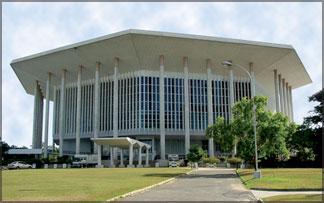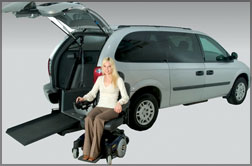Enabling built environment
Universal accessibility a modern prerequisite:
by Indeewara Thilakarathne and Ranga Chandrarathne
A Architecture is, by and large, the man made environment. From the
tiny by alleys to sky scrapers and the intricate network of road, make
up architecture. The architecture of a country not only reflects the
collective signature of a nation but also characteristics and
mentalities of the community at large.
Although architecture is influenced by many factors such as climate,
requirements and wants that it should fulfil, its universal feature is
accessibility. Easy accessibility is an inbuilt feature in both private
and public buildings.
However, little or no attention is paid to the specific requirements
of differently abled persons in constructing and designing buildings in
Sri Lanka. Perhaps, the architects would have over looked this, assuming
that almost all persons who use public and private buildings are
able-bodied men and women.
|

Only International Conference Hall that does not have
accessibility for the differently abled |
According to World Health Organization (WHO), 10 per cent of the
world's population are differently abled persons. Though it may be a
minuscule proportion in the population, it is a violation of human
rights if the built environment, including private and public buildings,
are inaccessible to this segment of citizens.
Architects, engineers and builders are not only professionals but
they are also custodians of our living environments.
However, the problem is increasing among a wide and diverse sector of
people which includes the elders, those with various debilitating
medical conditions, majority of whom are young people, victims of
natural disaster and man-made disasters such as road and home accidents
and even the pregnant mothers, all fighting a silent battle to access
and to make use of services and facilities provided by our public
buildings and public places.
What is sad to note is that the new buildings that are coming up in
Government sector as well as private sector including Super Markets,
most of the banks, restaurants, Shopping Complexes continue to
contribute to this problem.

With this there is a great social problem which affects the quality
of life of people and the economy of the country." said Dr. Ajith C. S.
Perera, a pioneer campaigner for enabling environment. He is also a
leader with proven competence in designing for inclusion of people.
A construction is successful or not successful, to the extent that
the built environment is accessible to 'All' people, for the purpose
with which the building and its facilities and services were designed
and meant to be used. It is the moral duty to take into account the
inevitable drop in human abilities when planning, designing and
constructing buildings.
If not the present trend, we see, in social exclusion created by man,
will accelerate. Looking at a building that has recently been done in
the country, especially the facilities at even five star hotels, is
proof that the professional building industry does not give any care to
this factor or do not have competence and knowledge in designing
rightly.
One major drawback that professionals in this industry have is that
none of them are wheel chair users or even using any mobility aid. They
lack this knowledge. So they have to rely on others. Unfortunately, they
have failed to keep in touch with differently abled who are the end
users," stressed Dr. Ajith Perera who has been a wheel chair user for
over ten years.

One of the examples for enabling environment is the accessible
facilities at the newly constructed Sethsiripaya. Dr. Ajith Perera's
initiation which enabled the UDA to construct private accessibility
facilities even for partially blind people adapting colour contrast
principles.
Investor's life, business sector along with the professionals in the
building industry should adapt a corporate policy that requires
inclusive designing to be a vital part of all concepts relating to
architecture and other designing.
It should be seen as an investment, not an expenditure and considered
at the design stage as an integral part of the development process.
Invariably, it's more expensive and tedious to reduce "created barriers,
with injurious contractions" than build right from the start.
Incorporating all inclusive design into building regulations and all
planning bodies is a must in order to ensure universal accessibility.
Although the regulation to access public buildings have already been
unanimously passed, so far constructors and professionals in the
construction industry have not paid due attention to it (Act regulation
No 1 of 17th October 2006). It is moral duty of citizens to ensure
universal accessibility to public and private buildings.
Designing accessible space in public, private and educational
buildings and service centres is an important step towards ensuring
universal accessibility; adequate floor space to accommodate a
stationary wheelchair and also space for a smooth U-turn, at least 1965
mm (78 inches) by 1525mm (60 inches).
In service centres and super markets facilities such as tables or
counters of various heights to accommodate standing , seating and also
shelves and medicine cabinets that can be reached by a wheel chair user,
should also be included in the initial designing.
Host of features such as wide doors with at least 815 mm (32 inches),
mount bathroom sinks with no higher than 865 mm (34 inches) from the
floor, grab bars in the shower and besides the toilet, a full-length
mirror that can be viewed by all, including children, should also be
included in the master design to facilitate disables. Shag carpets,
uneven brick floors, and other floor surfaces that could pose slipping
and tripping hazards should be avoided.
In addition, accessibility features can be incorporated into planning
urban spaces, designing public buildings such as health-centers,
commercial buildings, administrative complexes, service complexes,
cultural centers, recreational buildings, transportation buildings, and
industrial buildings.
One of the important factors that should be taken into consideration
is that universal accessibility and features of enabling built
environment have been implemented in developed countries and countries
affected by war.
[email protected]
***
"Access - a Human Rights issue"
MAKE IT HAPPEN
What is crucial at this stage is to take the 'Right Action' ICTAD and
the Chamber of Construction Industry should include their 'Building
Construction Standards and Requirements' Access Regulations that have
been gazetted on October 17, 2007 (Ref. 1467/15) along with SLSI
building standards.
They should also emphasis that these regulations are mandatory by law
and should be implemented and adhered to with effect from January 1,
2007. A wide awareness campaign should be carried out in this regard.
Apart from its legal position, it is the moral duty of all
professionals in the Building Industry, Property Developers as well as
investors and businessmen to respect this national concern and to make
sure that the constructions are universally accessible.
They should not hesitate to seek advice from end-users such as
wheelchair users so that margins for errors are nil. This is because
facilities that accommodate Wheelchair users will cover the needs of
People in all other sectors in society. |
